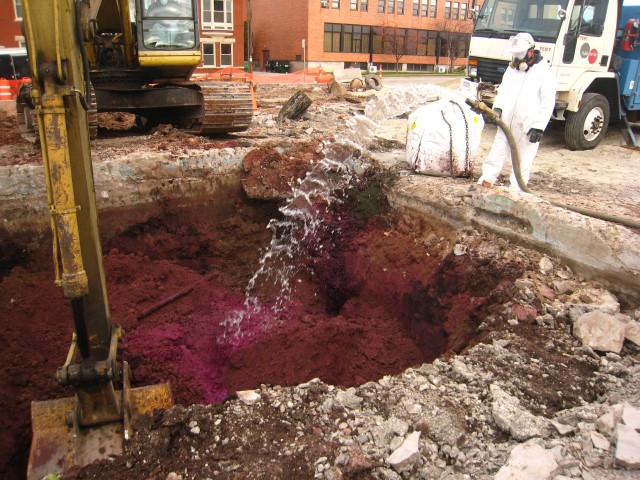When is an Environmental Site Assessment required?
Many communities suffer blight because of abandoned properties that do not generate value and pose a potential risk to public safety. Developers often consider abandoned properties — from small filling stations to industrial-scale factories — too complicated and costly for reuse. For municipalities, though, brownfield redevelopment projects offer opportunities to rebuild communities and revitalize deteriorated and contaminated property.
When exploring a brownfield redevelopment project, municipalities often begin with a question: When is an Environmental Site Assessment (ESA) required? An ESA is required when communities consider developing a potentially contaminated property. The results of this assessment will determine if a property has an environmental contamination from past use and if it poses any contamination or public health risk now. If contaminants are discovered, the assessment will present a strategy for cleanup and risk mitigation.
ESA: A comprehensive site investigation
An ESA process establishes the environmental condition of a property by considering past and present-day activities. The assessment process proceeds through two distinct phases.
Phase I ESA
The first phase identifies Recognized Environmental Conditions (RECs) using historical documents such as aerial photographs, Sanborn Fire Insurance maps, city directories and municipal records.Assessors may also review the area topography focusing on drainage from surrounding properties. This phase can include a physical site inspection and interviews with former owners or others with area knowledge.
The first phase may also establish who is potentially liable for any environmental contamination found on the property. Also critical is keeping a site eligible for United States Environmental Protection Agency Brownfields Assessment grant funds they may try to obtain. To keep a site eligible, a Phase I ESA must be completed before the municipality takes title to the property, even if the land is donated.
Phase II ESA
The second assessment phase is a vigorous on-the-ground investigation of site conditions. Soil, groundwater, vapor, surface water and sediment samples may be collected and tested. After examining and documenting environmental samples, investigators will compare them with applicable state and federal standards to determine if contamination exists above an established objective. Lead, petroleum hydrocarbons, pesticides, asbestos and industrial solvents are among the most common pollutants found during this analysis.
If the collected samples are free of contamination, redevelopment can proceed. However, if contamination is detected, regulatory authorities must be alerted, and the municipality will need to complete a structured cleanup process.
Failing to complete this testing can have disastrous repercussions as a project proceeds. Engaging with an experienced professional at this early stage of a project when an environmental site assessment is required can ensure your project starts from a strong foundation.
Transforming communities through brownfield restoration
With the right environmental and engineering team conducting your ESA, any former industrial or commercial site potentially can be approved for brownfield restoration. The process is technical, though, and it requires expertise across several key areas.
Knowledge of industry regulations and standards
The start is with a Phase I ESA that meets the American Society for Testing and Materials (ASTM) Standard 1527-13. Knowledge of state and federal standards, how to properly conduct a meaningful Phase II ESA and being able to progress to cleanup requires a multidisciplinary team with expertise in chemistry, environmental science, geology and engineering. Fehr Graham has that team to meet our clients' needs.
Ability to provide cleanup protocols
The role of an environmental engineering firm does not necessarily conclude after an assessment. If contamination exceeds risk thresholds for the proposed new use, a cleanup plan will be required to restore the site to functional use. This plan will be tailored to the specific brownfield and provide a range of cleanup protocols or controls based on site-specific RECs. Often, part of the site redevelopment is part of the environmental cleanup solution.
Expertise in securing EPA grant funding
Municipalities and public organizations, including regional councils and nonprofit organizations, may apply for EPA assistance to conduct brownfield restorations. The EPA awards nearly 300 grants a year worth about $60 million to help offset costs associated with assessment and cleanup.
An expert brownfields redevelopment firm should guide grant writing and management to navigate the ever-changing landscape of brownfield funding and regulation. This expertise can sometimes mean the difference between a failed project and a successful brownfield redevelopment.
Interviews with former owners and area experts
In this step, the assessment leverages community intellectual assets for a more nuanced understanding of the site. Interviewers may speak to previous owners or employees to better understand the site history. Likewise, area locals with an intimate knowledge of the site and its surroundings can provide further insights.
Knowledge gathered during this stage of the assessment presents a rich site history. The information aggregated through interviews and observation is then collated and analyzed by an expert team to determine potential threats and whether the project should proceed.
Know when an environmental site assessment is required
An Environmental Site Assessment is required whenever a municipality needs to understand a property's environmental state and its potential exposure to contamination. Likewise, ESAs can clarify the party responsible for site cleanup and restoration.
The highly detailed and multiphase nature of an ESA requires the attention of a professional environmental consulting firm with experience in taking brownfield redevelopment projects from initial assessment to final delivery. Under the care of the right team, abandoned and potentially dangerous brownfield sites can be renovated and renewed within the municipality's budget to cultivate and restore community health and vitality.
Fehr Graham offers premier engineering, environmental and funding solutions that can safely and successfully guide you through an Environmental Site Assessment. Contact Us to learn more about our services, or give us a call at 815.394.4700.
Collaborative, Insightful, Results-Driven Solutions
Fehr Graham provides innovative engineering and environmental solutions to help improve the lives and communities of our customers.


